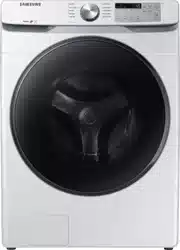Documents: Go to download!
User Manual
- User Manual - (English, Spanish)
- Energy Guide - (English)
User manual Washer
Step-by-step installation
STEP 1 Select a location
Location requirements:
- A solid, level surface without carpeting or flooring that may obstruct ventilation
- No direct sunlight
- Adequate room for ventilation and wiring
- Ambient temperature always higher than the freezing point (32 °F / 0 °C)
- Away from heat sources
STEP 2 Remove the shipping bolts
Unpack the product package and remove all shipping bolts.
- Loosen all shipping bolts on the rear of the machine using the spanner.
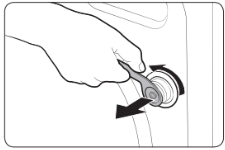
- Fill the holes with the supplied plastic bolt caps. Keep the shipping bolts for future use.
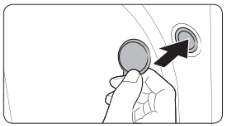
STEP 3 Adjust the leveling feet
- Gently slide the washer into position. Excessive force may damage the leveling feet.
- Using a wrench, turn the leveling feet clockwise or counterclockwise to adjust the height until the washer is level.
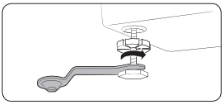
- Using a flathead screwdriver, tighten the locking nuts (A).
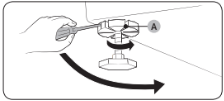
NOTE: An adjustable wrench or 17 mm open-end wrench is required to adjust the leveling feet.
STEP 4 Connect the water hose
CAUTION
- Make sure to use new water hoses and that rubber gaskets (B) are inside the couplings (A) at both ends of the hoses. Water hoses without the gaskets may leak.
- Allow 5 in. (127 mm) of space between the back of the washer and the wall to prevent water hoses from being kinked. Kinked hoses may cause water leaks.
- If there is a water leak, stop using the washer and contact a local Samsung service center. A water leak may cause electric shock.
- Do not stretch the water hoses by force. If a hose is too short, replace the hose with a longer hose.

- Attach the water hoses to the hot and cold water taps, and then hand tighten the water hose fittings until they are tight. Then, use pliers to tighten the fittings by an additional two-thirds of a turn. To avoid damaging the fittings, do not overtighten them.
- Pull the water hoses to check if they are firmly connected.
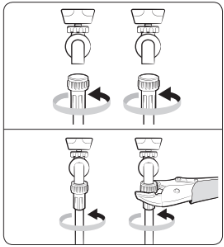
- Put the other ends of the hoses into a bucket, and then open the water taps for 10 - 15 seconds to remove impurities. When done, close the taps.
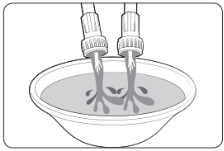
- Attach the water hoses to the hot and cold water inlets on the back of the washer, and then hand tighten the water hose fittings until they are tight. Then, use pliers to tighten the fittings by an additional two-thirds of a turn.

NOTE: If you do not want to use the hot water supply hose, attach the water intake cap to the hot water supply intake. When you do a wash, press Temp. to select Cold.
- Open the water taps, and check for leaks.
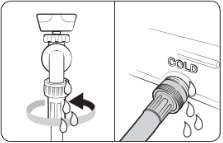
STEP 5 Connect the drain hose
To a Laundry Tub or Drain Pipe
Check the height (A) of your drain system and make sure the minimum and maximum heights shown below are met.
- Minimum 18 in. (46 cm)
- Maximum 96 in. (245 cm)
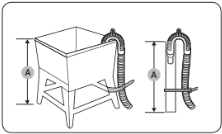
Attach the drain hose to the plastic hose guide (B).
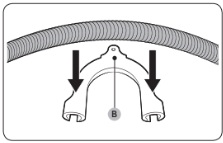
Route the drain hose to the drain system.

Secure the drain hose with cable ties.
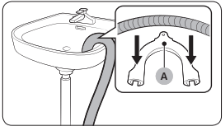
STEP 6 Remove the film inside the door
Remove the small circle of film (B) above the door latch before use.
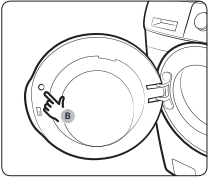
STEP 7 Power on
Plug the power cord into an AC 120 V / 60 Hz approved electrical outlet protected by a fuse or circuit breaker. Then, press Power to turn on the washer.
Before you start
Laundry guidelines
STEP 1 Sort
Sort the laundry according to these criteria:
- Care Label: Sort the laundry into cottons, mixed fibers, synthetics, silks, wools, and rayon.
- Color: Separate whites from colors.
- Size: Mixing different sized items together in the drum improves the washing performance.
- Sensitivity: Wash delicate items separately. For pure, new woolen items, curtains, and silk items, check the labels on the items.
STEP 2 Empty pockets
Empty all the pockets of your laundry items
- Metal objects such as coins, pins, and buckles on clothing may damage other laundry items as well as the drum.
Turn clothing with buttons and embroideries inside out
- If pants or jacket zippers are open while washing, the drum may be damaged. Zippers should be closed and fixed with a string.
- Clothing with long strings may become entangled with other clothes. Make sure to tie the strings before starting the wash.
STEP 3 Use a laundry net
- Brassieres (water washable) must be placed in a laundry net. Metal parts of the brassieres may break through and tear other laundry items.
- Small, light clothing such as socks, gloves, stockings, and handkerchiefs may become caught around the door. Place them inside a fine laundry net.
- Do not wash the laundry net by itself without other laundry. This may cause abnormal vibrations that could move the washer and result in injury.
STEP 4 Determine the load capacity
Do not overload the washer. Overloading may cause the washer to wash improperly.
- When washing bedding or bedding covers, the wash time may be lengthened or the spin efficiency may be reduced.
- For bedding or bedding covers, the recommended maximum spin level is Level 2 or Level 3, and the load capacity is 3.0 kg or less.
STEP 5 Add the correct detergent type
The type of detergent you use - general purpose, specifically for woolens, etc. - depends on the type of fabric (cotton, synthetic, delicate items, wool), color, wash temperature, and degree of soiling. Regardless of the specific type of detergent you use, always use “low suds” HE laundry detergent which is designed for automatic washers.
NOTE
- Follow the detergent manufacturer’s recommendations based on the weight of the laundry, the degree of soiling, and the hardness of the water in your local area. If you are not sure about the water hardness, contact your local water authority.
- Do not use detergent that tends to harden or solidify. This detergent may remain after the rinse cycle, blocking the drain outlet.
Operations
Control panel

01 Cycle Selector
- Turn the dial to select a cycle. (For more information about wash cycles, see page 35.)
02 Display
- The display shows current cycle information and estimated time remaining, or an information code if the washer needs to be checked.
03 Temp.
Press to change the water temperature for the current cycle.
- Hot (Level 5): Heavily soiled, colorfast items. Only available with NORMAL, HEAVY DUTY, SANITIZE and SELF CLEAN .
- (Level 4): Whites and heavily soiled, colorfast items.
- (Level 3): Colorfast items.
- (Level 2): Brightly colored, very lightly soiled items.
- Cold (Level 1): Uses only cold water without utilizing the washer's heater. No warm water is supplied.
04 Rinse
Press to change the rinse count for the current cycle.
- You can select 1 to 5 rinses.
05 Spin
Press to change the spinning speed for the current cycle.
- High (Level 5): Extends the spinning process to effectively remove moisture from the load. This level uses a stronger spinning process to remove moisture, so it is not suitable for wrinkle-free or non-iron fabrics, or overloads.
- (Level 4): Underwear, t-shirts, jeans, and sturdy cottons.
- (Level 3): Jeans, wrinkle-free or wash-and-wear items, and synthetics.
- (Level 2): Delicate items that require a lower spinning speed.
- No Spin (Level 1): The drum does not spin after the final drain process.
06 Soil
Press to change the soil level for the current cycle.
- Heavy (Level 5): For extremely soiled loads.
- (Level 4): For heavily soiled loads.
- (Level 3): For moderately soiled loads. This setting is best for most loads.
- (Level 2): For lightly soiled loads.
- Light (Level 1): For barely soiled loads.
07 Pre Soak
- Press to add 30 minutes of soaking time at the start of the wash cycle for better stain removal.
08 Steam
- Press to use the Steam function. The Steam function is available with NORMAL, HEAVY DUTY, WHITES, BEDDING, and SANITIZE. For heavily soiled, colorfast items, this function improves stain treatment and uses less water.
09 Delay End
- Set the washer to finish your wash automatically at later time. Choose a delay of between 1 to 24 hours (in 1 hour increments). (For more information about Delay End, see page 38.)
10 Alarm Off
- Press to turn the alarm sound on or off. When the alarm is off, the cycle completion melody and the power-off beep will not sound. However, button and alert sounds will remain on.
11 Power
- Press to turn the washer on or off
12 Start/Pause (Hold to Start)
- Press and hold to start operation or press to stop operation temporarily.
Simple steps to start

- Press Power to turn on the washer.
- Turn the Cycle Selector to select a cycle.
- Change the cycle settings (Temp., Rinse, Spin, and Soil) as necessary.
- Select desired options as necessary.
- Press and hold Start/Pause (Hold to Start).
To change the cycle during operation
- Press Start/Pause (Hold to Start) to stop operation.
- Select a different cycle.
- Press and hold Start/Pause (Hold to Start) again to start the new cycle.
Delay End
You can set the washer to finish your wash automatically at a later time by choosing a delay of between 1 to 24 hours (in 1 hour increments). The hour displayed indicates the time the wash will finish.
- Select a cycle. Then, change the cycle settings if necessary.
- Press Delay End repeatedly until a desired end time is set.
- Press and hold Start/Pause (Hold to Start).
- To cancel Delay End, restart the washer by pressing Power.
ATC (Auto Temperature Control)
ATC enables the washer to control water temperatures in each washing cycle using the internal thermistor. It is designed to maintain certain washing temperatures for best results.
NOTE
- If you select NORMAL or HEAVY DUTY, you may notice the washer supplying cold water. This is normal because the machine is designed to reduce power consumption. In these cycles, the water temperature for Level 5 is similar to bath-water temperatures, and Level 3 is similar to comfortable swimming pool temperatures.
- To wash clothes at a specific temperature, you must choose a different cycle first.
Child Lock
The Child Lock function locks the washer door to prevent children from climbing into and suffocating inside the drum.
To activate Child Lock
- Press and hold both Temp. and Rinse for 3 seconds. Then, press and hold Start/Pause (Hold to Start) to activate. The door locks, and the Child Lock indicator turns on.
To deactivate Child Lock temporarily
- You can deactivate Child Lock temporarily for 1 minute. To do this, press and hold both Temp. and Rinse for 3 seconds. The door is unlocked for 1 minute and the Child Lock indicator blinks.
NOTE
- If you open the door 1 minute after deactivating Child Lock, an alarm sounds for up to 2 minutes.
- If you close the door within 2 minutes, the door locks and Child Lock is reactivated. If you do not close the door or the door is not properly closed, the alarm keeps sounding for 2 minutes.
- To add laundry after activating Child Lock, deactivate Child Lock or restart the washer.
To cancel Child Lock
- Press and hold both Temp. and Rinse for 6 seconds. The door unlocks, and the Child Lock indicator turns off.
Alarm Off
You can turn the alarm sound on or off. When the alarm is off, the cycle completion melody and the power-off beep will not sound. However, the other sounds stay active.
- Press Alarm Off to turn the alarm on or off.
- Your setting will be kept even after you turn off and then restart the appliance.
Maintenance
Self Clean
Certain usage and environmental conditions may result in some residue build-up or odor in the washer drum. To prevent this build-up of residue or odor causing bacteria and keep your washer drum fresh and clean, perform the SELF CLEAN cycle at least once a month or every 40 cycles. Perform the recommended procedure below when using the SELF CLEAN cycle.
- Remove all items from the washer drum and ensure the drum is empty. Laundry left in the drum during the SELF CLEAN cycle may be damaged.
- Press Power to turn on the washer.
- Turn the Cycle Selector to SELF CLEAN .
- Press and hold Start/Pause (Hold to Start).
NOTE
- The water temperature for SELF CLEAN is defaulted to Hot. This temperature cannot be changed.
- In the case where residue is present in the washer drum, add liquid chlorine bleach to the MAX level line in the main-wash compartment before starting the SELF CLEAN cycle. Do not add the liquid chlorine bleach to the bleach compartment (This is only the case for SELF CLEAN cycle).
- Do not exceed the max line. Do not use or mix any other detergent or chemicals during the SELF CLEAN cycle. If necessary, run a RINSE+SPIN cycle after the SELF CLEAN cycle has completed to help remove any remaining residue.
Smart Care
To enable this function, you must first download the Samsung Laundry app from the Play Store or the App Store and install it on a mobile device that has a camera function. The Smart Care function has been optimized for Galaxy and iPhone mobile devices (applicable models only).
- When the washer detects an issue to check, an information code appears on the display. To enter Smart Care mode, press and hold Soil for 3 seconds.
- The washer starts the self-diagnosis procedure and displays an information code if a problem is detected.
- Run the Samsung Laundry app on your mobile device, and then tap Smart Care.
- Put the mobile device close to the washer’s display so that the smartphone camera and the washer face each other. The information code will be recognized automatically by the app.
- When the information code is recognized correctly, the app provides detailed information about the problem with applicable solutions.
NOTE
- The function name, Smart Care, may differ depending on the language.
- If the washer's display reflects light, the app may fail to recognize the information code.
- If the app fails to recognize the information code, you can enter the code manually on the app.
Emergency drain
In case of a power failure, drain the water inside the drum before taking out the laundry.
- Turn off the washer, and then unplug the power cord.
- Gently press the top area of the filter cover to open.
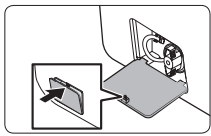
- Put an empty, spacious container around the cover, and stretch the emergency drain tube to the container while holding the tube cap (A).
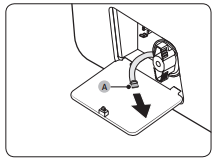
- Open the tube cap and let water in the Emergency drain tube (B) flow into the container.
- When done, close the tube cap, and reinsert the tube. Then, close the filter cover.
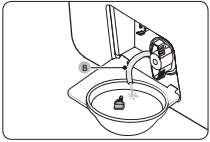
Cleaning
Surface of the washer
Use a soft cloth with a nonabrasive household cleaner. Do not spray water onto the washer.
Mesh filter
Clean the mesh filter of the water hose once or twice a year.
- Turn off the washer, and then unplug the power cord.
- Close the water tap.
- Loosen and disconnect the water hoses from the back of the washer. Cover the each hose with a cloth to prevent water from gushing out.
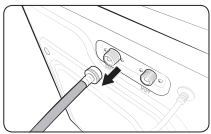
- Use pliers to pull out the mesh filter from the inlet valves.
- Thoroughly clean the mesh filters in water.
- Completely dry the mesh filters. Do not dry in direct sunlight.
- Reinsert the mesh filters, and then reconnect the water hoses.
- Open the water taps.

Pump filter
You should clean the pump filter 5 or 6 times a year to prevent it from clogging. A clogged pump filter may reduce the bubble effect.
- Turn off the washer, and then unplug the power cord.
- Gently press the top area of the filter cover to open.
- Drain the remaining water inside the drum. See the Emergency drain section on page 42.
- Turn the pump filter knob (A) counterclockwise, and then drain the remaining water.
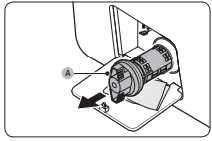
- Clean the pump filter using a soft brush. Make sure the drain pump propeller inside the filter is not clogged.
- Reinsert the pump filter, and then turn the filter knob clockwise.
- Close the filter cover.

NOTE
- Some pump filters feature a safety knob that is designed to prevent children from accidentally opening the filter compartment. To open the safety knob of the pump filter, push in and turn it counterclockwise. The spring mechanism of the safety knob helps open the filter.
- To close the safety knob of the pump filter, turn it clockwise. The spring makes a rattling sound, which is normal.
- Before closing the filter cover, make sure the pump filter is properly inserted.
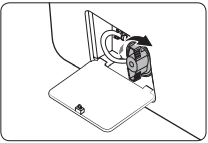
Door diaphragm
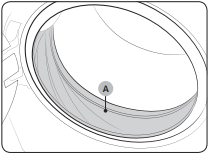
- Open the door, and then empty the drum.
- Combine 3/4 cups of liquid chlorine bleach and 1 gallon of warm tap water.
- Wearing rubber gloves, use a soft, clean cloth dipped in the water and bleach solution to clean the diaphragm.
- Let stand 5 minutes, and then wipe up and dry well.
Recovery from freezing
The washer may freeze when the temperature in its location drops below 32 °F (0 °C).
- Turn off the washer, and then unplug the power cord.
- Pour warm water over the water tap to loosen the water hose.
- Disconnect the water hose, and then soak it in warm water.
- Pour warm water into the drum and leave it for about 10 minutes.
- Reconnect the water hose to the water tap.
Care for an extended period of non-use
Avoid leaving the washer unused for an extended time. However, if you intend to leave the washer unused for a long period of time, follow the directions below:
- Press Power, and then turn the Cycle Selector to RINSE+SPIN.
- Empty the drum, and then press and hold Start/Pause (Hold to Start).
- When the cycle is complete, close the water taps and disconnect the water hoses.
- Turn off the washer, and then unplug the power cord.
- Open the door to let air circulate through the drum.
Troubleshooting
Does not start.
- Make sure the washer is plugged in.
- Make sure the door is properly closed.
- Make sure the faucets are open.
- Make sure to press or tap Start/Pause (Hold to Start) to start the washer.
- Make sure Child Lock is not activated.
- Before the washer starts to fill, it will make a series of clicking noises to check the door lock and does a quick drain.
- Check the fuse or reset the circuit breaker.
Water supply is insufficient, or no water is supplied.
- Fully open the faucet.
- Make sure the door is properly closed.
- Make sure the water supply hose is not frozen.
- Make sure the water supply hose is not kinked or clogged.
- Make sure there is sufficient water pressure.
After a cycle, detergent remains in the detergent drawer.
- Make sure the washer is running with sufficient water pressure.
- Make sure you add liquid detergent to the liquid detergent container. Make sure to remove the liquid detergent container if you are using powdered detergent.
- Clean the detergent drawer.
Excessive vibrations or makes noise.
- Make sure the washer is installed on a level, solid floor that is not slippery. If the floor is not level, use the leveling feet to adjust the height of the washer.
- Make sure the shipping bolts are removed.
- Make sure the washer is not contacting any other object.
- Make sure the laundry load is balanced.
- The motor can cause noise during normal operation.
- Overalls or metal-decorated clothes can cause noise while being washed. This is normal.
- Metal objects such as coins can cause noise. After washing, remove these objects from the drum or filter case.
Does not drain and/ or spin
- Make sure the drain hose is neither kinked nor obstructed all the way to the drain system. If there is a drain restriction, call for service.
- Make sure the debris filter is not clogged.
- Close the door and press or tap Start/Pause (Hold to Start). For your safety, the washer will not tumble or spin unless the door is closed.
- Make sure the drain hose is not frozen or clogged.
- Make sure the drain hose is connected to a drain system that is not clogged.
- If the washer is not supplied with sufficient power, the washer temporarily will not drain or spin. As soon as the washer regains sufficient power, it will operate normally.
The door does not open.
- Press or tap Start/Pause (Hold to Start) to stop the washer.
- It may take a few moments for the door lock mechanism to disengage.
- The door will not open until 3 minutes after the washer has stopped or the power turned off.
- Make sure all the water in the drum is drained.
- The door may not open if water remains in the drum. Drain the drum and open the door manually.
- Make sure the door lock light is off. The door lock light turns off after the washer has drained.
- If the washer is paused after the water is supplied, the door cannot be opened until one minute has passed.
Excessive suds.
- Make sure you use the recommended types and amounts of detergent.
- Use high efficiency (HE) detergent to prevent oversudsing.
- Reduce the detergent amount for soft water, small loads, or lightly soiled loads.
- Don't use Non-HE detergent.
Cannot add additional detergent.
- Make sure the remaining amount of detergent and fabric softener is not over the limit.
The washer stops.
- Plug the power cord into a live electrical outlet.
- Check the fuse or reset the circuit breaker.
- Close the door and press Start/Pause (Hold to Start) to start the washer. For your safety, the washer will not tumble or spin unless the door is closed.
- Before the washer starts to fill, it will make a series of clicking noises to check the door lock and does a quick drain.
- There may be a pause or soak period in the cycle. Wait briefly and the washer may start.
- Make sure the mesh filter of the water supply hose at the faucets is not clogged. Periodically clean the mesh filter.
- If the washer is not supplied with sufficient power, the washer temporarily will not drain or spin. As soon as the washer regains sufficient power, it will operate normally.
Fills with the wrong temperature water.
- Fully open both taps.
- Make sure the temperature selection is correct.
- Make sure the hoses are connected to the correct taps. Flush water lines.
- Make sure your water heater is set to supply hot water with a minimum temperature of 120 °F (49 °C) at the tap. Also, check the water heater capacity and recovery rate.
- Disconnect the hoses and clean the mesh filters. The mesh filters may be clogged.
- While the washer fills, the water temperature may change as the automatic temperature control feature checks incoming water temperature. This is normal.
- While the washer fills, you may notice just hot and/or just cold water going through the dispenser when cold or warm temperatures are selected. This is a normal function of the automatic temperature control feature as the washer determines the water temperature.
The load is wet at the end of a cycle.
- Use the High or Extra High spin speed.
- Use high efficiency (HE) detergent to reduce oversudsing.
- The load is too small. Small loads (one or two items) may become unbalanced and not spin completely.
- Make sure the drain hose is not kinked or clogged.
Leaks water
- Make sure the door is properly closed.
- Make sure all hose connections are tight.
- Make sure the end of the drain hose is correctly inserted and secured to the drain system.
- Avoid overloading.
- Use high efficiency (HE) detergent to prevent oversudsing.
Has odors.
- Excessive suds collect in recesses and can cause foul odors.
- Run cleansing cycles to sanitize periodically.
- Clean the door seal (diaphragm).
- Dry the washer interior after a cycle has finished.
After a cycle, washer is not off and/or the door does not open.
- If the Remaining Laundry Notification is on, press Power to turn the power off, and then remove the items.
- If the SELF CLEAN indicator is on, remove all items from the drum, and then run the SELF CLEAN cycle.
Information codes
If the washer fails to operate, you may see an information code on the screen. Check the table below and try the suggestions.
1C
Check the water level sensor.
- Power the washer off. Wait 2-3 minutes, power the washer on, and then try again.
- Depending on the model, the drain system drains water automatically. The Power and Start/Pause (Hold to Start) buttons may be disabled during this process.
DC
The door is open.
- Close the door and press Start/Pause (Hold to Start) to resume operation.
DC1
Check the door switch.
- Power the washer off. Wait 2-3 minutes, power the washer on, and then try again.
LC
Check for water leaks.
- Power the washer off, and then check the drain system for any leaks. Once the leak issue is resolved, power the washer on.
- Depending on the model, the drain system may drain water automatically. The Power and Start/Pause (Hold to Start) buttons may be disabled during this process.
4C
Check the water supply line.
- Check the connection to the water lines (including water taps).
- Power the washer off. Wait 2-3 minutes, power the washer on, and then try again.
- Depending on the model, the drain system may drain water automatically. The Power and Start/Pause (Hold to Start) buttons may be disabled during this process.
4C2
Laundry needs protection because the water being supplied is too hot.
- Make sure the cold and hot water taps are properly connected.
- Power the washer off. Wait 2-3 minutes, power the washer on, and then try again.
5C
Check the drain system.
- Make sure the drain filter is not clogged.
- If the drain filter is clogged, clean the filter, and then restart the washer.
HC
Check the washing heater.
- Power off the washer, and then contact a Samsung service center.
UB
Check the spinning process.
- The load may not be balanced inside the drum. Check the drum and make sure the load is balanced.
- Press Start/Pause (Hold to Start) to resume operation or power the washer off, wait 2-3 minutes, power the washer on, and then try again.
8C, 8C1, 8C2
Check the MEMS sensor.
- Power the washer off. Wait 2-3 minutes, power the washer on, and then try again.
OC
Water may overflow.
- Close the water valve and call for service.
3C
Check the motor.
- Power the washer off. Wait 2-3 minutes, power the washer on, and then try again.
AC6
Check the PBA communication status.
- Power the washer off. Wait 2-3 minutes, power the washer on, and then try again.
9C1, 9C2
The electronic control needs to be checked.
- Check if power is supplied properly.
- If the information code remains, contact a Samsung service center.
SF
System failed.
- Power off the washer, and then contact a Samsung service center.
See other models: WF45M5500AW P1043/P843 DVG50R5200W WA50M7450AP WV60M9900AW
